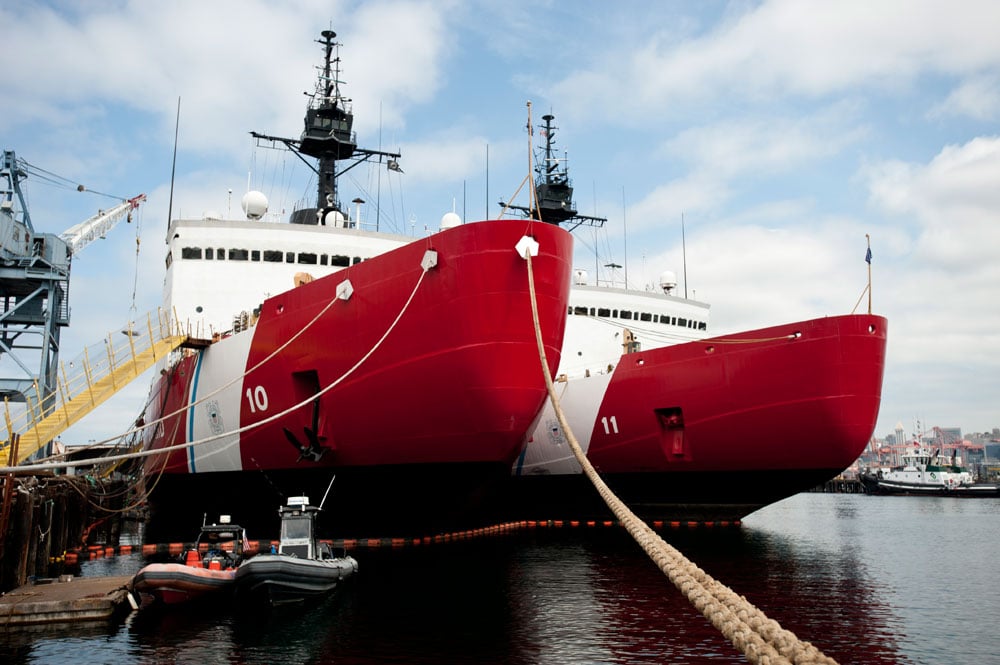
The Coast Guard will likely need help from other government agencies to fund its proposed new $1 billion heavy icebreaker the service says it needs to operate in the Arctic and Antarctic, outgoing USCG commandant Adm. Robert Papp told reporters Wednesday following his final State of the Coast Guard address in Washington, D.C.
“The Coast Guard shouldn’t bear the full brunt of the cost of the icebreaker because it serves the entire country not just the United States Coast Guard,” Papp said.
“It’s going to probably cause some concern when I say the Department of Defense, there are national security issues in the Arctic and Antarctic and the Navy used to run the fleet of icebreakers and they were transferred to us. I’m not saying Navy, but the Department of Defense has needs to get into Antarctica and the Arctic. We can provide that capability, but it should be a shared expense.”
The Coast Guard’s annual budget is significantly smaller than any of the other services. Its Fiscal Year 2014 budget submission was a mere $9.79 billion with a shipbuilding budget of $743 million. In comparison, the U.S. Navy’s shipbuilding account request alone was $14.3 billion.
The service has been in consultation with other U.S. agencies that have Arctic and Antarctic interests — including the Department of Interior and the National Science Foundation.
Once a year the Coast Guard sends an icebreaker to clear the way to NSF McMurdo Station in Antarctica to clear a channel to the station for resupply and transport of NSF scientists for research missions.
Currently the almost 40-year-old refitted USCGC Polar Star (WAGB-10) is in the region preforming the McMurdo mission.
Polar Star underwent a $90 million overhaul to extend the life of the ship until the new icebreaker comes online.
Papp hinted at some of the requirements for the new ship, which the service was given $8 million in its Fiscal Year 2013 budget to begin working on preliminary designs.
He said the new ship should combine the ice breaking ability of Polar Star with the extensive laborites and accommodations of the service’s 1990s vintage medium icebreaker USCGC Healy (WAGB-20).
As an example, he said the Coast Guard was asked to preform a scientific mission with Polar Star but the lack of accommodations for scientists on the icebreaker would have required a second ice-hardened ship to ferry the scientists.
“We need to take Polar Star’s ice breaking capability with Healy’s amenities for the new icebreaker, Papp said.
“That’s why we’re getting the input from all of the other departments.”
Papp also recommended against overhauling Polar Star’s sister ship, Polar Sea.
“We don’t think it’s a viable option simply because it costs a lot of money,” he said.
“I’d rather see that money going toward a new icebreaker that can serve the country for 40 years rather than pouring money into a questionable project that would only last us a few years.”

The icebreaker design start was one of several projects Papp managed to start during his four-year tenure as commandant. Others included the acquisition of 14 C-27J Spartan cargo planes from the Air Force to replace aging C-130H maritime surveillance aircraft and the start of the new class of 25 Offshore Patrol Cutters that will replace the current Famous and Reliance class cutters which the youngest — USCGC Mohawk (WMEC-913) — entered service in 1991.
“The offshore patrol cutter is the most important — not just shipbuilding — but the most important acquisition program that the Coast guard has done in its history,” Papp told reporters following the address on Wednesday.
“It’s huge — 25 ships. We’ve never bought a run of 25 major ships.”
Earlier this month, the service awarded $65 million in design contracts to three shipbuilders — Bollinger Shipyards in Lockport, La., Eastern Shipbuilding in Panama City, Fla. and General Dynamics, Bath Iron Works (BIW) in Bath, Maine.
The service plans to select the final hull design following an 18-month evaluation period.
“We are far from getting the first ships built. It’s going to take some constant attention and monitoring,” Papp said.
“Even if we build them at two a year, it’s going to be 15 years before we get them built out. That’s going to occupy my relief, his relief and those beyond for quite awhile.”
Papp is expected to leave the service in the next several months. His replacement has yet to be announced.





